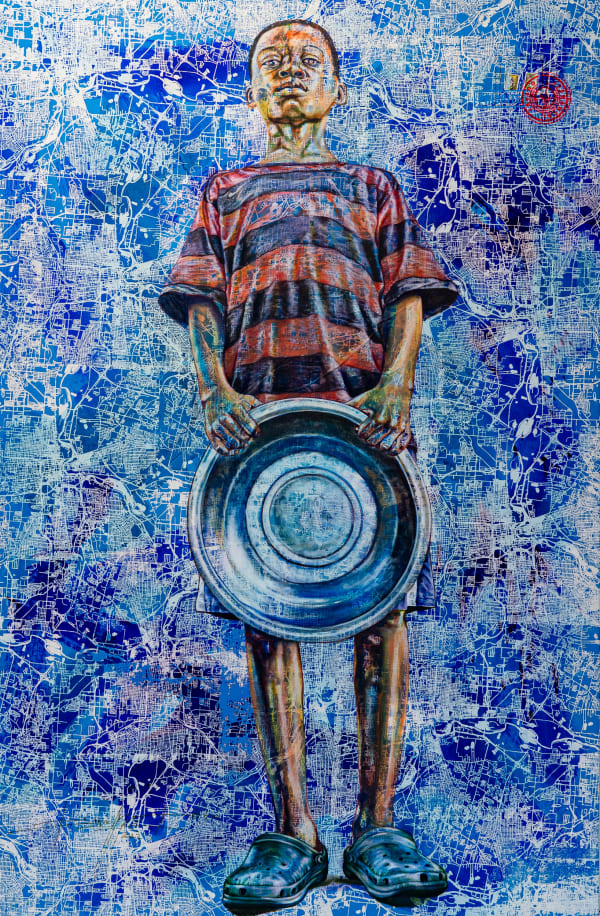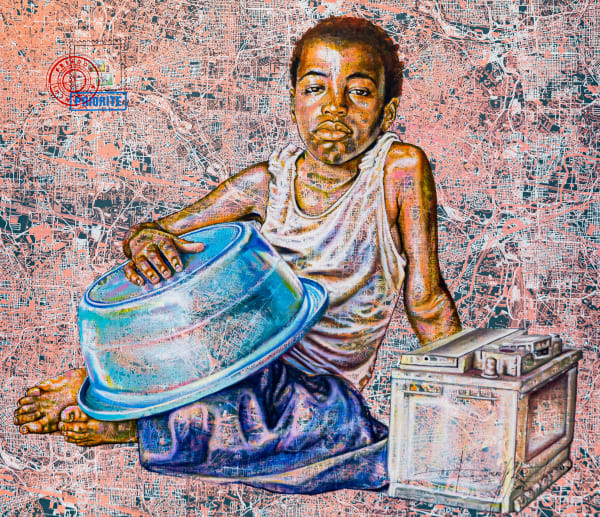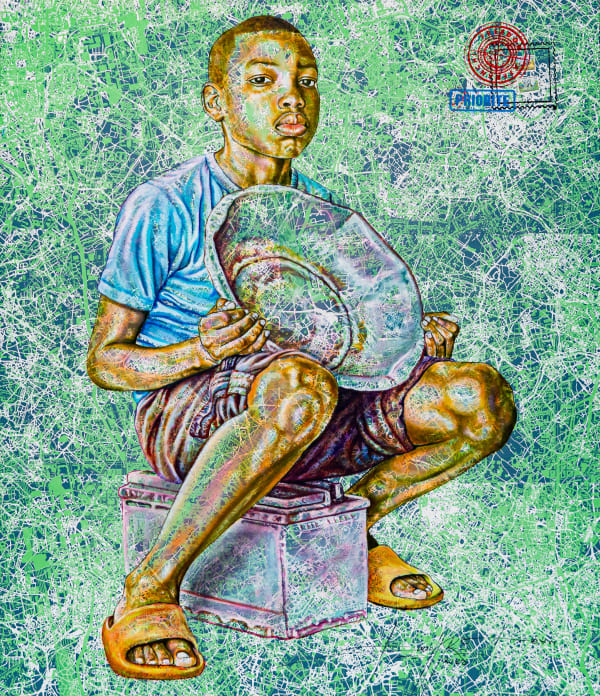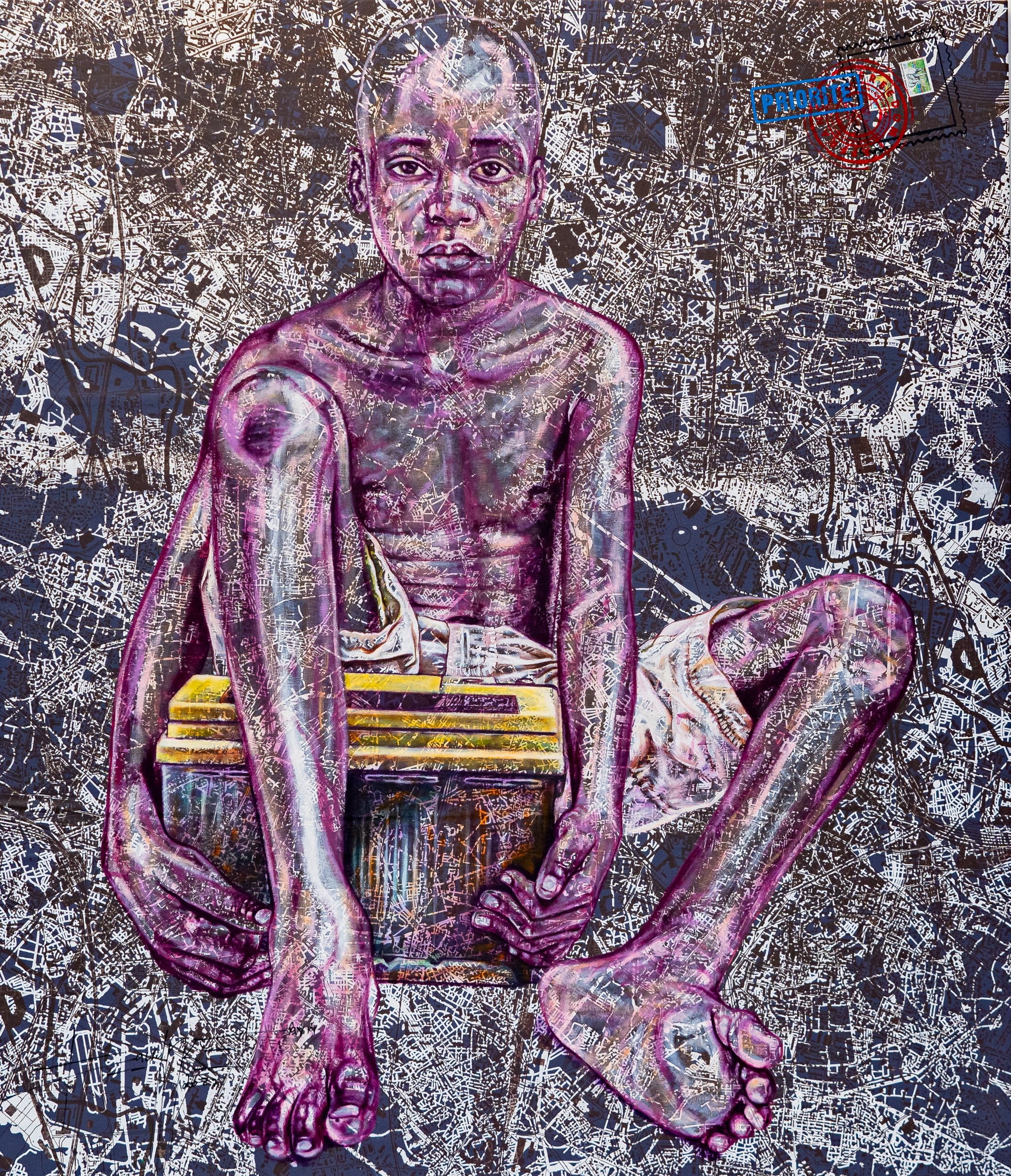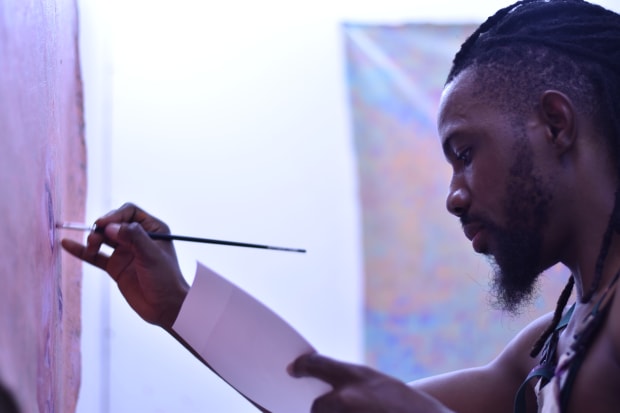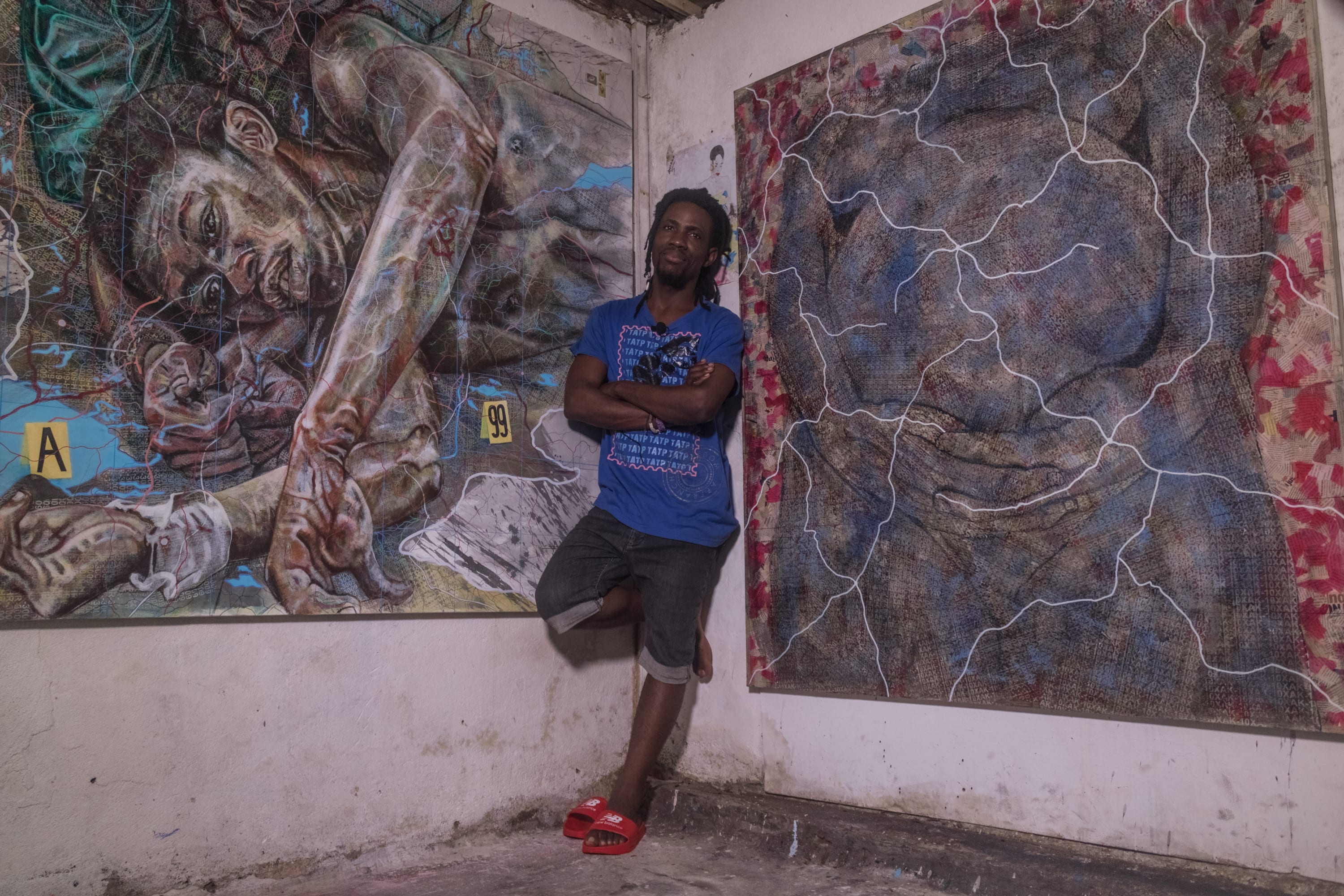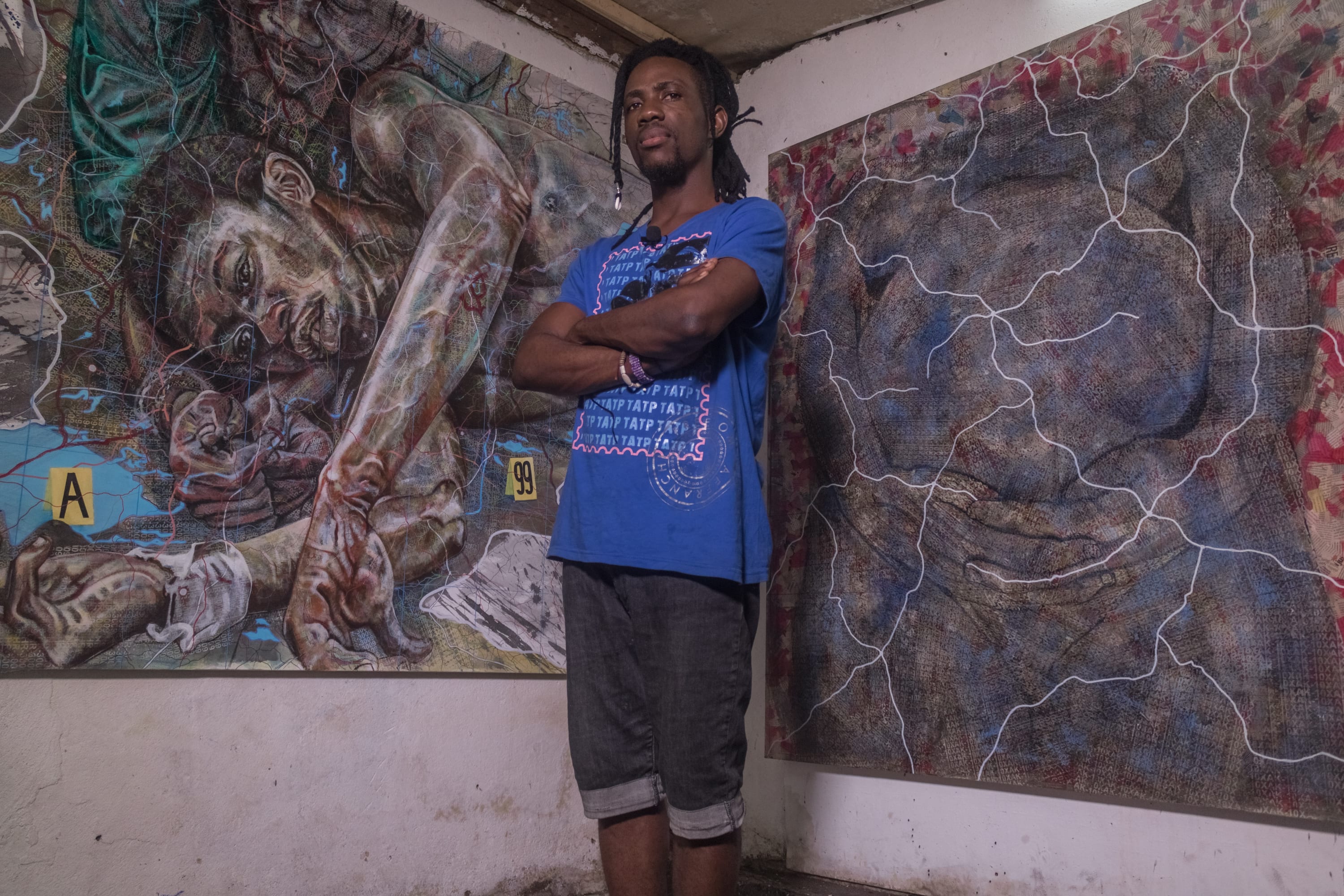-
The other's face
Simon NjamiIn this new series, the gaze becomes clearer. The organic foreigner that is the migrant gives way to another form of strangeness, more subtle and cruel and which South Africans have had the outrageous experience of: being a stranger to oneself, or, in to be more precise, to be a stranger where everything would lead us to believe that we are at home.Jean-David Nkot is above all, at least for the moment, a painter. His work, even when it contains elements of abstraction, is essentially figurative, obsessed with the body and its representation. The black body, is it necessary to specify it. Even if this famous “black body” may appear as an old story, maybe should we explore Nkot’s position a bit deeper. Nkot, since his first canvases, paints and depicts himself. In a camouflaged, metaphorical way, but with a confused desire to create an autobiography of the possible. The important thing is not that he appears conspicuously in his paintings, but that his paintings carry a bit of this story that Nkot seeks to untie. This story has Africa as its background, whether present or suggested. In previous works, he questioned the nature of displacement in its most contemporary and political expression, which is migration. Recent history has shown young teenagers who, embarking for a hypothetical, illusory and artificial promised land, have completed their journey at the bottom of the oceans and seas. For those who have managed to maintain a meaningless life, another adventure, perhaps even more traumatic than the first, began: that of the foreigner, the renegade, the refugee. The aborted dream they carried inside them has shrunk to a trickle and here they are, confronted with the sad reality of exile and identity questioning.Jean-David Nkot is above all, at least for the moment, a painter. His work, even when it contains elements of abstraction, is essentially figurative, obsessed with the body and its representation. The black body, is it necessary to specify it. Even if this famous “black body” may appear as an old story, maybe should we explore Nkot’s position a bit deeper. Nkot, since his first canvases, paints and depicts himself. In a camouflaged, metaphorical way, but with a confused desire to create an autobiography of the possible. The important thing is not that he appears conspicuously in his paintings, but that his paintings carry a bit of this story that Nkot seeks to untie. This story has Africa as its background, whether present or suggested. In previous works, he questioned the nature of displacement in its most contemporary and political expression, which is migration. Recent history has shown young teenagers who, embarking for a hypothetical, illusory and artificial promised land, have completed their journey at the bottom of the oceans and seas. For those who have managed to maintain a meaningless life, another adventure, perhaps even more traumatic than the first, began: that of the foreigner, the renegade, the refugee. The aborted dream they carried inside them has shrunk to a trickle and here they are, confronted with the sad reality of exile and identity questioning.In this new series, the gaze becomes clearer. The organic foreigner that is the migrant gives way to another form of strangeness, more subtle and cruel and which South Africans have had the outrageous experience of: being a stranger to oneself, or, in to be more precise, to be a stranger where everything would lead us to believe that we are at home. I mentioned the migrants who came to South Africa and were victims of xenophobia from those who participated to their freedom, but the strangeness that Nkot addresses also appears in the countries from which the characters described come from. This is no longer a racial strangeness, but a social divide.In speaking of the foreigner, I invoke two ontologically contradictory notions: that of the foreigner who frightened Plautus (Lupus est homo homini, non homo, quom qualis sit non novit) and which we have just briefly covered and that of the maverick used by James Baldwin to define himself and also, why not, at Camus' Meursault. Baldwin defined himself as a maverick and Meursault, Camus' character as an "stranger", because neither matched what their communities expected of them. The Anglo-Nigerian photographer Rotimi Fani-Kayodé defined himself as an outsider. But these last examples, even if they evoke an intra-community misunderstanding, cannot apply to the characters portrayed by Nkot. The latter find themselves rejected even beyond the community of which they are a part and therefore, nothing is expected of them. A strange character, as Plautus could have said, is an uprooted person without any identifiable attachment. We could, in other circumstances, have used these same terms to define freedom, since the principle that governs the latter is precisely the fact of not being accountable to anyone. This is an enviable position. I've always suspected the notion of “roots”, which seems to be coming back into fashion. I no longer know what those who use and abuse it mean. The root is now inseparable from race, nation, homeland... As if it were not a random occurrence but a kind of certificate of origin that we oppose to the “Other”. W.E.B. Dubois who announced the color line as an essential issue of the twenty-first century, was he wrong? The color or the origin (since now the two merge) has become a vector of tension, despite the gray areas it implies, since there is no absolute color, but aggregates, mixtures. And each to throw his roots in the face of the other. What do the roots tell us if we think about it, if not an underground movement invisible to the eye and whose ramifications are of infinite complexity. The impoverishment of discourse for personal, individual, community ends invalidates any debate which is de facto, reduced to the zero degree of thought. Appropriations and reappropriations, recriminations, demands for a rewriting of history constitute a formless chaos of dissonant noises.
The stranger portrayed in Nkot's latest series doesn't have to be burdened with all that ideological jumble. He does not care about the gaze of the other who crosses him without seeing him. He does not need to forge a fake identity since he belongs to the land on which he lives. He is part of this community that we call Nation. This identity, official, legal, cannot be refused to him. The identity denied to him is of a completely different nature: it is that of his personality, of his persona. An identity, I use this word deliberately to oppose it to the notion of national identity, which owes nothing to anyone but is the result of a constant work on oneself that Jung called individuation. It is necessary, in the alchemical process described by the psychoanalyst, to succeed in getting rid of all the rags that constituted us in order to forge, in the athanor of our mind, a new personality. So as to fully embody what Heidegger will call Dasein, “being-in-the-world”). The characters described by Nkot are deprived of their "dasein", they are invisible humans, to use the word Ralph Ellison, who described the situation of black Americans during the years of segregation in the United States: social invisibility, political invisibility, legal invisibility… But the invisibility that opposes, in Ellison, blacks and whites takes on another accent when it comes to individuals of the same race.
These cannot even count as pariahs (which would still represent a form of identity) since their lives and their actions are not acknowledged in the evolution of the society they inhabit. They are not invisible, they are anonymous:
“In evoking the anonymity of this existence, I am not thinking at all of this indeterminate background that we talk about in philosophy manuals and where perception cuts things up. This indeterminate ground is already a being – a been – a something. It already falls into the category of the noun. He already has that elementary personality which characterizes all existing. »
Levinas, like Jung, mentions the importance of this personality without which, as soon as we are deprived of it, we are nothing. And it is on this "primal personality" that Nkot's gaze lingers. Suddenly, his brush gives them back the human dimension they are denied. Most of the time his subjects look at him. They face him, as if they were posing for a photograph, a testimony to come. Time is stopped, the space of this moment when, suddenly, they come back to life. The accessories with which they surround themselves, or with which the artist adorns them, are only accessories, often the same ones, which come to insist on the derisory, anecdotal side of what these makeshift tools represent in our century of high technology. We will not say that they are proud. They are, and this is already essential. In rereading the quote from Lévinas, I stop for a moment on this “indeterminate background” which is mentioned in reference to philosophy manuals and where “perception cuts things up”. Observing Nkot's paintings, it is this same sensation that seizes me: his perception cuts out things, in this case, beings, and the indeterminate background on which he inscribes them adds a dreamlike side to this non-place that the characters inhabit. But whatever his primary intention may have been, the artist escapes, through this abstraction of the decor, a misery that would have been out of place here. Two essential moments of this particular human condition are depicted: innocence, perhaps lost, and fatigue.
Ordinary fatigue, the one you can experience after hard work but which suddenly takes on apocalyptic overtones: this man on whose shoulders three comrades are placing an excessively heavy load, this child collapsed on sacks, these three pieta supporting a form of which we do not know whether it is a dead or a living person, and these entangled bodies, fallen into the field of labor. The body returns. But it is nothing more than an inert mass, emptied of all energy. But let's leave these bodies aside to come back to the faces.
“This face exposed to my gaze is disarmed. Whatever the countenance he gives himself, whether this face belongs to an important character, labeled or seemingly simpler. This face is the same, exposed in its nudity. Beneath the countenance he gives himself all his weakness breaks through and at the same time his mortality emerges. So much so that I may want to liquidate it completely, why not? However, this is where all the ambiguity of the face lies, and of the relationship to the other. This face of the other, without recourse, without security, exposed to my gaze in its weakness and its mortality, is also the one that orders me: “Thou shalt not kill”. »
The disarmed face of a raped innocence, of an aborted childhood is what we find ourselves confronted with. In a style that borrows from a certain realism without however completely inhabiting it, by this decor which would correspond well to the word utopia invented by Thomas Moore (and which means no place, or nowhere), Nkot creates a world outside the world. A metaphorical parenthesis. There is no compassion in these paintings (that would have betrayed a position of superiority), but compassion. There is this look that confronts ours. Which challenges us to pass without seeing. Which drives into our consciousness a truth that, perhaps, we would have preferred to avoid. And to come back to the theory of the self-portrait, I cannot get rid of the intuition that Nkot paints his characters as he could have painted himself. But in order to avoid any confusion, it is important to look beyond the obvious. In the same way that the backgrounds are ethereal, these characters are only metaphors, beings without physical consistency and without real location.
They seem to be African, maybe the children of the victims of the xenophobic episodes that shook South Africa, but maybe they are Syrians, Ukrainians, Chinese, Black Americans, Palestinians… Nkot, whatever may be chosen geography, could have been one of them. He is one of them. They are all him.
-
 Jean David Nkotwww.connected body.fr, 2022Acrylic, silkscreen on canvas300 x 200 x 5 cm
Jean David Nkotwww.connected body.fr, 2022Acrylic, silkscreen on canvas300 x 200 x 5 cm -
About the artist
Jean David NkotMy work used to focus on migration. However, it was a way to depict the human condition. Thus, it is not all about migration but more about the human condition. For me, the human condition gathers the inequalities existing between individuals. This notion also includes the way they consider each other. For a year now, my work has been exploring the topic of raw materials to depict this human condition – Jean David Nkot Born in 1989 in Douala, Cameroon, where he lives and works Jean David Nkot is a Cameroonian artist whose work has been exhibited in London, New York, Berlin, France and Yaounde. After painting for his A-levels at the Institute of Artistic Training of Mbalmayo (IFA), he joined the Institute of Fine Arts Foumban where he obtained a degree in drawing and painting. Throughout his training in the fine arts of Foumban, he received several artist distinctions (Best sculptor, installer and painter). In 2017, he joined the « Post-Master » Moving Frontiers, organised by the National School of Arts of Paris-Cergy (France), on the theme of borders. Conscious of what his elders can bring him, he is frequently in the workshops of Hervé Youmbi, Salifou Lindou, Jean Jacques Kanté, Pascal Kenfack and Ruth Belinga.Concerned with the human condition, Nkot works with layers to build up meaning in his mixed-media paintings, telling the story of the subject depicted as well as the wider narrative of the place in which they live – although sometimes, out of necessity, he allows a native of one country to take on and “tell” the story of another. Nkot also explores the mismanagement of raw materials and the mining industry in Africa, Nkot seeks to show the strength and resilience of the people he portrays, not just their suffering.Mercedes Rosés highlights how Nkot creates what he calls ‘molecule maps,’ where he superimposes maps from their surroundings and keywords onto the human subjects. He states that his inspiration comes from artist Thomas Hirschhorn, “Like him, I circle keywords and link them together. I call them ‘maps molécules’ because their structure reminds me of molecules and atoms. By creating a network of data, with information gravitating around a central word, I want to show that they are all connected, that no simple notion stands alone, and that one seemingly straightforward issue can pave the way for a broader debate. At first sight, this mass of information can seem incoherent, senseless – only to reveal the hidden complexity that lies behind it.”
Born in 1989 in Douala, Cameroon, where he lives and works Jean David Nkot is a Cameroonian artist whose work has been exhibited in London, New York, Berlin, France and Yaounde. After painting for his A-levels at the Institute of Artistic Training of Mbalmayo (IFA), he joined the Institute of Fine Arts Foumban where he obtained a degree in drawing and painting. Throughout his training in the fine arts of Foumban, he received several artist distinctions (Best sculptor, installer and painter). In 2017, he joined the « Post-Master » Moving Frontiers, organised by the National School of Arts of Paris-Cergy (France), on the theme of borders. Conscious of what his elders can bring him, he is frequently in the workshops of Hervé Youmbi, Salifou Lindou, Jean Jacques Kanté, Pascal Kenfack and Ruth Belinga.Concerned with the human condition, Nkot works with layers to build up meaning in his mixed-media paintings, telling the story of the subject depicted as well as the wider narrative of the place in which they live – although sometimes, out of necessity, he allows a native of one country to take on and “tell” the story of another. Nkot also explores the mismanagement of raw materials and the mining industry in Africa, Nkot seeks to show the strength and resilience of the people he portrays, not just their suffering.Mercedes Rosés highlights how Nkot creates what he calls ‘molecule maps,’ where he superimposes maps from their surroundings and keywords onto the human subjects. He states that his inspiration comes from artist Thomas Hirschhorn, “Like him, I circle keywords and link them together. I call them ‘maps molécules’ because their structure reminds me of molecules and atoms. By creating a network of data, with information gravitating around a central word, I want to show that they are all connected, that no simple notion stands alone, and that one seemingly straightforward issue can pave the way for a broader debate. At first sight, this mass of information can seem incoherent, senseless – only to reveal the hidden complexity that lies behind it.” -
We walk in our flesh
-
 Jean David Nkot#body depredation@. cm.org, 2022Acrylic, silkscreen on canvas300 x 200 x 5 cm
Jean David Nkot#body depredation@. cm.org, 2022Acrylic, silkscreen on canvas300 x 200 x 5 cm -
In CORPS DE P@GES, Nkot lovingly presents the human form in different poses, each as a living being, each with their own story, each part of contemporary history, and a contributor and window to society.Bodies speak, they love, they argue, they cry, they despair and throughout they hope for a better future for them and theirs. Nkot calls on us to recognise and respect and value not only our fellow man, but all living things.
-
 Jean David NkotPo.Box. weight of technology.com, 2022Acrylic, silkscreen on canvas300 x 200 x 5 cm
Jean David NkotPo.Box. weight of technology.com, 2022Acrylic, silkscreen on canvas300 x 200 x 5 cm -
The stranger portrayed in Nkot's latest series doesn't have to be burdened with all that ideological jumble. He does not care about the gaze of the other who crosses him without seeing him. He does not need to forge a fake identity since he belongs to the land on which he lives. He is part of this community that we call Nation. This identity, official, legal, cannot be refused to him. The identity denied to him is of a completely different nature: it is that of his personality, of his persona. An identity, I use this word deliberately to oppose it to the notion of national identity, which owes nothing to anyone but is the result of a constant work on oneself that Jung called individuation. It is necessary, in the alchemical process described by the psychoanalyst, to succeed in getting rid of all the rags that constituted us in order to forge, in the athanor of our mind, a new personality. So as to fully embody what Heidegger will call Dasein, “being-in-the-world”). The characters described by Nkot are deprived of their "dasein", they are invisible humans, to use the word Ralph Ellison, who described the situation of black Americans during the years of segregation in the United States: social invisibility, political invisibility, legal invisibility… But the invisibility that opposes, in Ellison, blacks and whites takes on another accent when it comes to individuals of the same race.- extract from Simon Njami's exhibition text
-
 Jean David Nkotfr.cm.body in boby.gmail.com,, 2022Acrylic, silkscreen on canvas300 x 200 x 5 cm
Jean David Nkotfr.cm.body in boby.gmail.com,, 2022Acrylic, silkscreen on canvas300 x 200 x 5 cm -
We carry in our worlds that flourish. Our worlds that have failied
-
Nkot creates a world out of the world. A metaphorical parenthesis. There is no compassion in these paintings (it would have betrayed a position of superiority), but compassion. There is this look that confronts ours. Which challenges us to pass without seeing. Which sinks into our consciousness a truth that, perhaps, we would have preferred to avoid. And going back to the theory of self-portraiture, I can't get rid of the intuition that Nkot paints his characters as he could have painted himself.
–Simon Njami
The artist feels compelled to bring attention to how the body and nature are often the victims in our search for industrialisation and the belief in a purely capitalistic economic model.Nkot aims to give a voice to the people who despite their enormous contribution and sacrifice of their own health and wealth remain in the shadows with little say in terms of their future and that of their families, communities, or country.Vast fortunes are built on their sweat with little thought given to improving their plight as it is in this very poverty, lack of education and subjugation of thought and spirit that they are forced to continue to work for the wealthy and the powerful. -
 Jean David Nkot#karl@laveur de minerais bissi.org, 2022Acrylic, silkscreen on canvas140 x 213 x 2.5 cm
Jean David Nkot#karl@laveur de minerais bissi.org, 2022Acrylic, silkscreen on canvas140 x 213 x 2.5 cm -
The ‘@’ symbol, and the titles of the artworks represent website domains and email addresses thereby bringing further attention to the power of the internet, the role that it plays in controlling society and restricting free thought through the desire to fit in to preconceived notions of what is right and what is wrong, what is good and what is bad.
-
 Jean David NkotPo.Box. cold look, 2022Acrylic, silkscreen on canvas128 x 110 x 2.5 cm
Jean David NkotPo.Box. cold look, 2022Acrylic, silkscreen on canvas128 x 110 x 2.5 cm -
In studio
-
-
-
Within his work, Nkot compensates for the lack of visibility and recognition of those who work in the shadows. By giving them the status of contemporary icons, he invites us to rethink our economic model to protect 'man' and the planet together
CORPS DE P@GES: Jean David Nkot
Past viewing_room
Jean David Nkot explores the plight of the ‘common man’ in his first solo to be presented in South Africa. The exhibition is accompanied by an exhibition text written by Simon Njami.
This powerful body of paintings navigates the exploitation of the populations of the developing world by those who come in search of wealth, possessions, and power.






